More thoughts about tactics
King of the spill tried to develop a theory about tactics. If such theory will help to improve your chess is another matter, but I see developing theories as a means to clear up the mess that usually resides in the head. A sort of defragmentation of the hard disk so to speak.
I have a lot of fragments which are not put together into a consistent theory, but maybe King or others will derive some idea's from it.
I divide tactics in two main area's.
To win a piece (be it a king or otherwise) from the enemy there are two possibilities.
Trap.
The first one is the TRAP.
Here is only ONE target involved.
If you are after a target, it usually escapes after every move you do to attack it. Ad infinitum (=move 50:).
Only if the target has a lack of SPACE you have chances to catch it.
I consider checkmate as a special case of a TRAP.
Duplo attack.
The second possibility is the DUPLO ATTACK.
I posted about this earlier. I use this name to distinguish it from the term "double attack", which is a part of all possible duplo attacks.
A duplo attack means that there are TWO TARGETS involved.
I use the following distinctions:
1-2 attackers
1-2 attack squares
2 target squares
2 targets
A few examples:
diagram 1

White to move
Blue= attacking square
Green= target square
The attacker is allready on its attacking square and the targets are allready on their target square.
This is the common picture of a double attack.
A similar picture can be made for a double attack of a knight (phork), a queen, king, bishop, pawn.
diagram 2
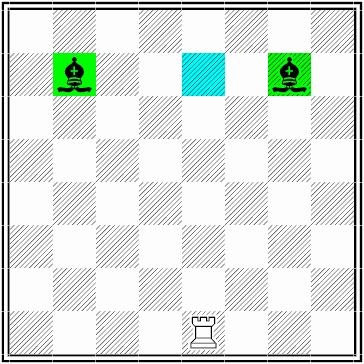
White to move
Blue= attacking square
Green= target square
The same sitiation as above, but the rook isn't on its attacking square yet.
Diagram 3

White to move
Blue= attacking square
Green= target square
The targets are in line with the attacker.
Depending on the values of the hostile pieces this is called a pin or a skewer.
diagram 4
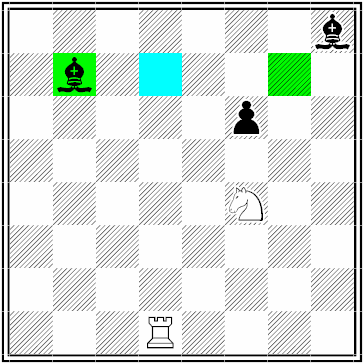
White to move
Blue= attacking square
Green= target square
A coloured square can be subject for some actions.
Here one of the target squares is empty yet. There are all sorts of preparational moves that forces the target to the target square. Here you can drive the bishop with Ng6 to its target square.
diagram 5
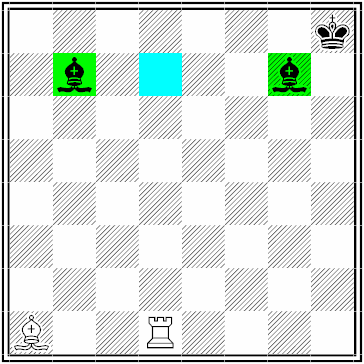
White to move
Blue= attacking square
Green= target square
Here you use another preparational move to force the king to its target square.
A simple exchange Bxg7 will do the job.
If the value of the piece you exchange is higher than the one you get for it, the exchange is called a sacrifice.
It works about the same with the attacking squares.
It can be necessary to clear the attacking square by chase away the defender, by exchanging or sacrificing on the square etc..
diagram 6
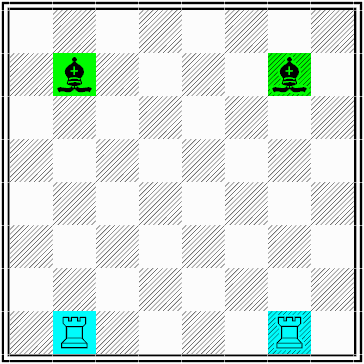
White to move
Blue= attacking square
Green= target square
Here you have the most basic form of an attack with two attackers.
The attackers are allready placed on the attacking squares and the targets are allready placed on the target squares. You will probably never find this basic form in practice.
diagram 7
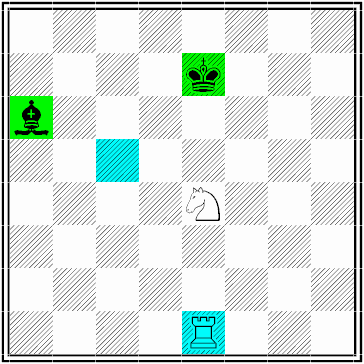
White to move
Blue= attacking square
Green= target square
By placing the knight on its attacking square both attacks come into action.
diagram 8

White to move
Blue= attacking square
Green= target square
Clearance. By moving the knight away, both attacks come into action.
Summary.
There are two methods to win a piece:
A duplo attack can be descibed with:
I have a lot of fragments which are not put together into a consistent theory, but maybe King or others will derive some idea's from it.
I divide tactics in two main area's.
To win a piece (be it a king or otherwise) from the enemy there are two possibilities.
Trap.
The first one is the TRAP.
Here is only ONE target involved.
If you are after a target, it usually escapes after every move you do to attack it. Ad infinitum (=move 50:).
Only if the target has a lack of SPACE you have chances to catch it.
I consider checkmate as a special case of a TRAP.
Duplo attack.
The second possibility is the DUPLO ATTACK.
I posted about this earlier. I use this name to distinguish it from the term "double attack", which is a part of all possible duplo attacks.
A duplo attack means that there are TWO TARGETS involved.
I use the following distinctions:
- There are ONE or TWO attackers.
- There is an attacking square. This is the square from where the attacker attacks. An attacker can be allready on its attacking square or not
- There is a target square. A target can allready be on it's target square or not.
- The two targets are IN LINE with the attacker or not.
1-2 attackers
1-2 attack squares
2 target squares
2 targets
A few examples:
diagram 1

White to move
Blue= attacking square
Green= target square
The attacker is allready on its attacking square and the targets are allready on their target square.
This is the common picture of a double attack.
A similar picture can be made for a double attack of a knight (phork), a queen, king, bishop, pawn.
diagram 2

White to move
Blue= attacking square
Green= target square
The same sitiation as above, but the rook isn't on its attacking square yet.
Diagram 3

White to move
Blue= attacking square
Green= target square
The targets are in line with the attacker.
Depending on the values of the hostile pieces this is called a pin or a skewer.
diagram 4

White to move
Blue= attacking square
Green= target square
A coloured square can be subject for some actions.
Here one of the target squares is empty yet. There are all sorts of preparational moves that forces the target to the target square. Here you can drive the bishop with Ng6 to its target square.
diagram 5

White to move
Blue= attacking square
Green= target square
Here you use another preparational move to force the king to its target square.
A simple exchange Bxg7 will do the job.
If the value of the piece you exchange is higher than the one you get for it, the exchange is called a sacrifice.
It works about the same with the attacking squares.
It can be necessary to clear the attacking square by chase away the defender, by exchanging or sacrificing on the square etc..
diagram 6

White to move
Blue= attacking square
Green= target square
Here you have the most basic form of an attack with two attackers.
The attackers are allready placed on the attacking squares and the targets are allready placed on the target squares. You will probably never find this basic form in practice.
diagram 7

White to move
Blue= attacking square
Green= target square
By placing the knight on its attacking square both attacks come into action.
diagram 8

White to move
Blue= attacking square
Green= target square
Clearance. By moving the knight away, both attacks come into action.
Summary.
There are two methods to win a piece:
- A trap
- A duplo attack.
A duplo attack can be descibed with:
- 8 elements (2 attackers, 2 attacking squares, 2 target squares, 2 targets)
- Preparational moves to get the attackers on the attacking squares and the targets on the target squares.
- Are the targets in line with the attacker.
- Are there one or two attackers.
Excellent. I shall try to think of counterexamples :)
ReplyDeleteThe only thing I would add is that there are up to N target squares and targets, where N depends on the piece(s) attacking. For rook, knight, bishop, N=4; pawn N=2; queen, N=8. I have succumb to many knight triple forks in my games. This ignores the two attacking pieces, which complicates things even more.
Nice. I also like what bdk said. We could almost make this into a math problem. :) I'll try to think of my own tactics theory.
ReplyDeleteI like it, especially the "trapping" connection to checkmate. That dynamic seems also to extend to perpetual check/perpetual chase/etc, putting those into more of a space difficulty rather than time difficulty.
ReplyDeleteI see your "Duplo attack" as a timing problem, i.e. the defense doesn't have enough tempi to disentangle both threats.
What I forgot to mention is that I see the pieces that are involved with the preparational moves as "auxiliary troops" and not as key elements in the combinations. For example the white knight in diagram 4, the white bishop on a1 and the black bishop on g7 in diagram 5.
ReplyDeleteNice theory. It does help to explain why tactics work. But does it help seeing a tactic when sitting at the board, fighting? I would like to hope so, but I have my doubts. I am inclined to think «either you see it, or you don't see».
ReplyDelete"Auxiliary" is a great term for it.
ReplyDeleteMousetrapper - I see these theories as something that helps with understanding your own mistakes or breaking down difficult tactics problems, i.e. preparation and post-mortem work improves your play.